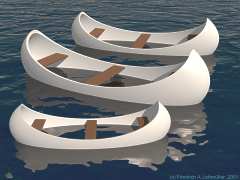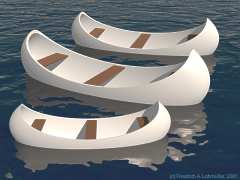Home
- POV-Ray Tutorial
- POV-Ray Examples
Index of Content
- Geometry
- Architecture
- Engineering
- Ladder
- Pylons
- Railing
- Bridge
- Tubes
- Tube Fork
- Tube Stopcock
- Chain
- Coil of Wire
- Torpedo
- Cruise Missile
- Rocket
- Wheel
- Truck
- Propeller
- Airplanes
- Canoe
- Guitar Body
- 7-Segment Display
- Ribbon Cable
- Cable Harness
|
|
Canoe in the Water
Construction of a Canoe
and positioning on the water
by "transform{...}"
Objects: sphere, box.
Methods: #declare, union, intersection, inverse, transform.
|
|
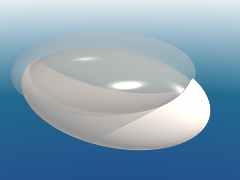 |
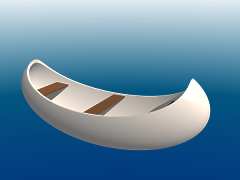 |
| The outline is an ellipsoid - it becomes a canoe. |
|
|
The shape of an ellipsoid forms the outside of a canoe.
This shape is caved out by a smaler scaled version of itself.
("intersection" with "inverse")
From this an ellipsoid will be cut off:
#declare Canoe_outside=
sphere {<0,0,0>,1 scale <3,1.5,1> translate<0,0.5,0> }
//-----------------------------------------------------
#declare Canoe =
intersection{
object{ Canoe_outside }
object{ Canoe_outside scale <0.98,0.95,0.94> inverse}
sphere {<0,0,0>,1 scale <2.5,1,20> translate<0,1.3,0> inverse}
texture{pigment{color White*1.1}
finish {ambient 0.45 diffuse 0.55 phong 1}}
} // end of outside structure of the canoe ------------------- |
Naturally we should addmit us some seats inside of the canue!
If we place the canoe simply on the surface of the water
the user will get wet feed!
|
 |
To avoid this we must subtract
the outside shape of the canoe
from the water plane
right at the same place we want to position our canoe
|
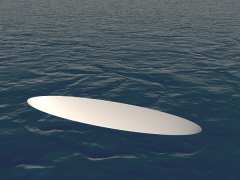 |
| Like this a canoe is pure fun!
|
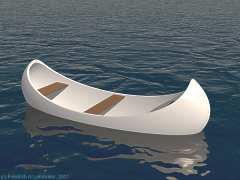 |
To make it easier to put the hole in the water right in the same position as the canoe,
it is recommanded to define the position and may be also any rotation in a transformation:
#declare Canoe_Position1
= transform{ rotate < 0,30, 0> translate<0,0,1>} |
This transformation then can be used as well as for our canoe also for the hole in the water (Canoe_outside):
//-------------------------------------< place canoe
object{ Canoe transform Canoe_Position1}
// -----------------------------------< hole in the water
difference{
plane{<0,1,0>, 0 } // the water
object{Canoe_outside
transform Canoe_Position1 } // the hole
texture{Polished_Chrome
normal {crackle 1 scale 5
turbulence 1 translate<0,0,5>}
finish {diffuse 0.5
reflection 0.4}}
}// end of difference
//---------------------------------------------------- end |
The real effectivity of this method naturally comes into play only if we can afford
more than one canoe!
Scene file for a canoe in POV-Ray:
"canoe.txt"
|
|






